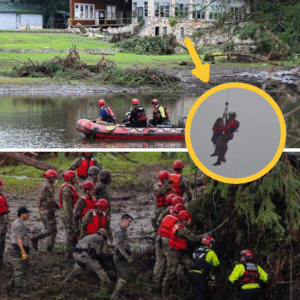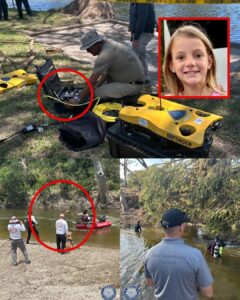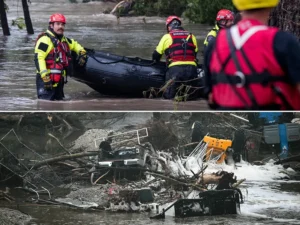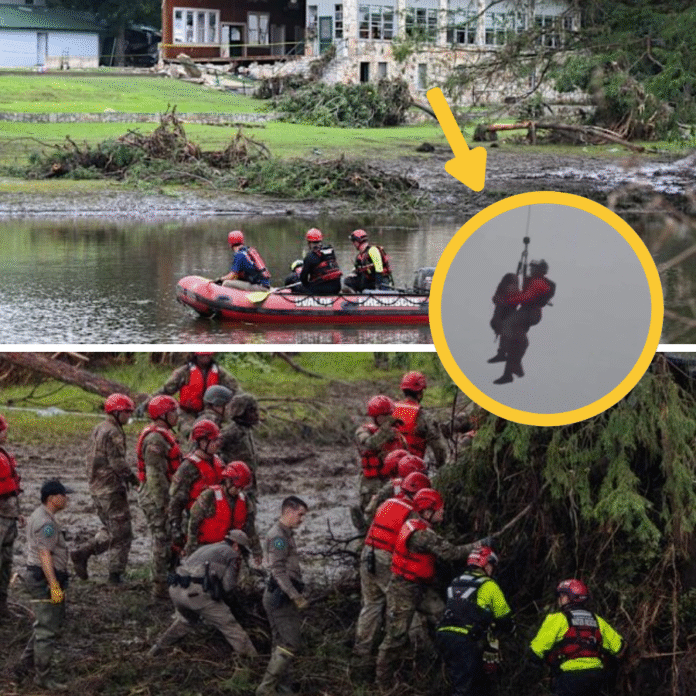A Haunting Discovery at Camp Mystic: The Tragic Aftermath of the Texas Floods
On the morning of August 5, 2025, a chilling scene unfolded at Camp Mystic, a nearly century-old Christian girls’ summer camp nestled along the Guadalupe River in Texas Hill Country. Rescuers, who had been tirelessly combing the riverbanks for days, spotted movement near the old mess hall, a central gathering place for campers. Hope surged briefly—could this be a sign of survivors from the catastrophic flooding that struck on July 4, claiming the lives of 27 campers and counselors? But as they approached the door, what they found was not a survivor but an eerie relic: an untouched remnant from the night the tragedy unfolded, a stark reminder of the 27 young lives lost when the river surged without warning. This discovery, reported just moments ago, has deepened the grief enveloping the Camp Mystic community and the nation.

The Night of the Flood
Camp Mystic, founded in 1926, has long been a cherished haven for girls aged 7 to 17, offering activities like archery, canoeing, and spiritual devotion in a wholesome Christian environment. On July 4, 2025, approximately 750 girls were at the camp, many asleep in cabins along the Guadalupe River, when torrential rains from the remnants of Tropical Storm Barry triggered a catastrophic flash flood. The river, normally a serene backdrop for camp activities, surged from 3 feet to nearly 35 feet in less than an hour, transforming the idyllic retreat into a scene of chaos and devastation.
The flooding struck between 2 and 3 a.m., catching counselors and campers off guard. Low-lying cabins, particularly Bubble Inn and Twins I & II, where the youngest girls—many just 8 years old—were housed, bore the brunt of the deluge. The water blew out windows, swept away bunk beds, and carried personal belongings downstream. Counselors, some as young as 18, acted heroically, breaking windows to free trapped girls and guiding others to higher ground. Despite their efforts, 27 lives were lost, including camp director Richard “Dick” Eastland, who died attempting to rescue campers.
The Search for Answers
Since the tragedy, search and rescue operations have been relentless. Over 1,700 responders, including Coast Guard swimmer Scott Ruskan, who saved 165 people, have scoured the riverbanks, debris piles, and surrounding areas. Helicopters, boats, and canine units have been deployed, but as days turned into weeks, the mission shifted from rescue to recovery. By July 9, the death toll across Central Texas reached 110, with over 170 people, including 10 campers and one counselor from Camp Mystic, still unaccounted for. The discovery near the mess hall today marks a poignant moment in this ongoing effort.

The item found—its nature undisclosed in initial reports—had remained untouched since that fateful night, a silent witness to the terror that unfolded. For the rescuers, it was a gut-wrenching reminder of the lives lost, particularly in Bubble Inn, where 13 girls and two counselors perished. The cabin, described as a simple, open room with metal bunk beds and a community bathroom, was a place where lifelong friendships were forged. Now, it stands as an epicenter of grief, marked by white crosses bearing the names of the fallen.
A Community in Mourning
The loss of 27 campers and counselors, including 8-year-olds like Blakely McCrory, Virginia Wynne Naylor, and twins Hanna and Rebecca Lawrence, has shattered the tight-knit Camp Mystic community. For nearly a century, the camp has been a rite of passage for Texas families, including political elites like the daughters of former governors and Laura Bush, a former counselor. Its traditions—singing camp songs, earning buttons for milestones, and forming bonds in cabins like Bubble Inn—have shaped generations.
Parents, alumni, and survivors are grappling with unimaginable grief. Lindsey McLeod McCrory, whose daughter Blakely died wearing a green-and-white Camp Mystic necklace, described the camp as a place of profound connection. “I gave this necklace to my daughter right before camp,” she said, recalling how it symbolized her support during a time of personal loss after her husband’s death. Other families, like those of Lila Bonner and Janie Hunt, have shared similar stories of vibrant young girls whose lives were cut short.
Counselors like Ainslie, a 19-year-old who risked her life to save 16 girls, and Chloe Childress, an 18-year-old who died mentoring her campers, have been hailed as heroes. Their actions, like writing names on campers’ arms with Sharpies for identification, reflect the courage displayed amid chaos. Yet, survivors like Ainslie also carry deep sorrow, questioning how such a tragedy could strike a place of joy and faith.
Questions and Accountability

The tragedy has sparked debate about preparedness and accountability. Camp Mystic’s emergency plans, reviewed just days before the flood, directed staff to move to higher ground in case of flooding. However, the speed and scale of the deluge overwhelmed these measures. The Guadalupe River, part of Texas’ flood-prone “Flash Flood Alley,” had no alarms in the camp’s vicinity, and spotty cell service hindered communication. Some have questioned why low-lying cabins like Bubble Inn were not evacuated sooner, though accounts suggest counselors believed they were safe until it was too late.
Critics have also pointed to systemic issues. Local officials in Kerr County were reportedly unaware of the unfolding catastrophe until hours after it began, leaving campers and staff to fend for themselves initially. A Reddit user noted that a NOAA Weather Radio or earlier response to a 1 a.m. flash flood warning might have made a difference, though hindsight offers little solace. Texas Governor Greg Abbott has vowed that the search will “stop at nothing” to find the missing, but for many parents, the prolonged uncertainty has compounded their trauma.
A Legacy of Resilience
Despite the devastation, stories of resilience and community have emerged. Survivors like 10-year-old Lucy Kennedy, who found comfort in singing camp songs during the ordeal, and 13-year-old Stella Thompson, who made it to higher ground, embody the spirit of Camp Mystic. Alumni like Olivia Marrus, who attended for 10 summers, describe the camp as a place that taught bravery, kindness, and faith. “It’s hard not to feel like you are surrounded by a higher power when you’re down there,” she said, reflecting on the beauty of the Texas landscape that once felt so safe.
The camp’s leadership, now without Dick Eastland, faces an uncertain future as it plans to rebuild. The Eastland family, who have run Camp Mystic for generations, has been a cornerstone of its legacy. George Eastland, Dick’s grandson, called his grandfather a “hero” who died saving others, a sentiment echoed by former campers who credit the camp with shaping their lives.
A Call for Healing
As the search continues, the discovery near the mess hall underscores the ongoing pain of the Camp Mystic tragedy. The untouched relic—perhaps a camper’s belonging or a piece of the camp’s history—serves as a haunting symbol of loss and a call to remember the 27 lives lost. The community is rallying, with funds established in honor of victims like Wynne Naylor and efforts to return keepsakes like stuffed animals to grieving families.
Texas, known for its resilience, is coming together to support the affected families. As Allyson Bebleu, a volunteer serving recovery workers, said, “Everyone is putting themselves in the shoes of the Camp Mystic girls. It’s tragic.” The nation watches as this storied camp, once a place of joy, navigates an unthinkable loss, holding onto hope and the enduring lessons of courage and community that define the “Mystic Girls.”



